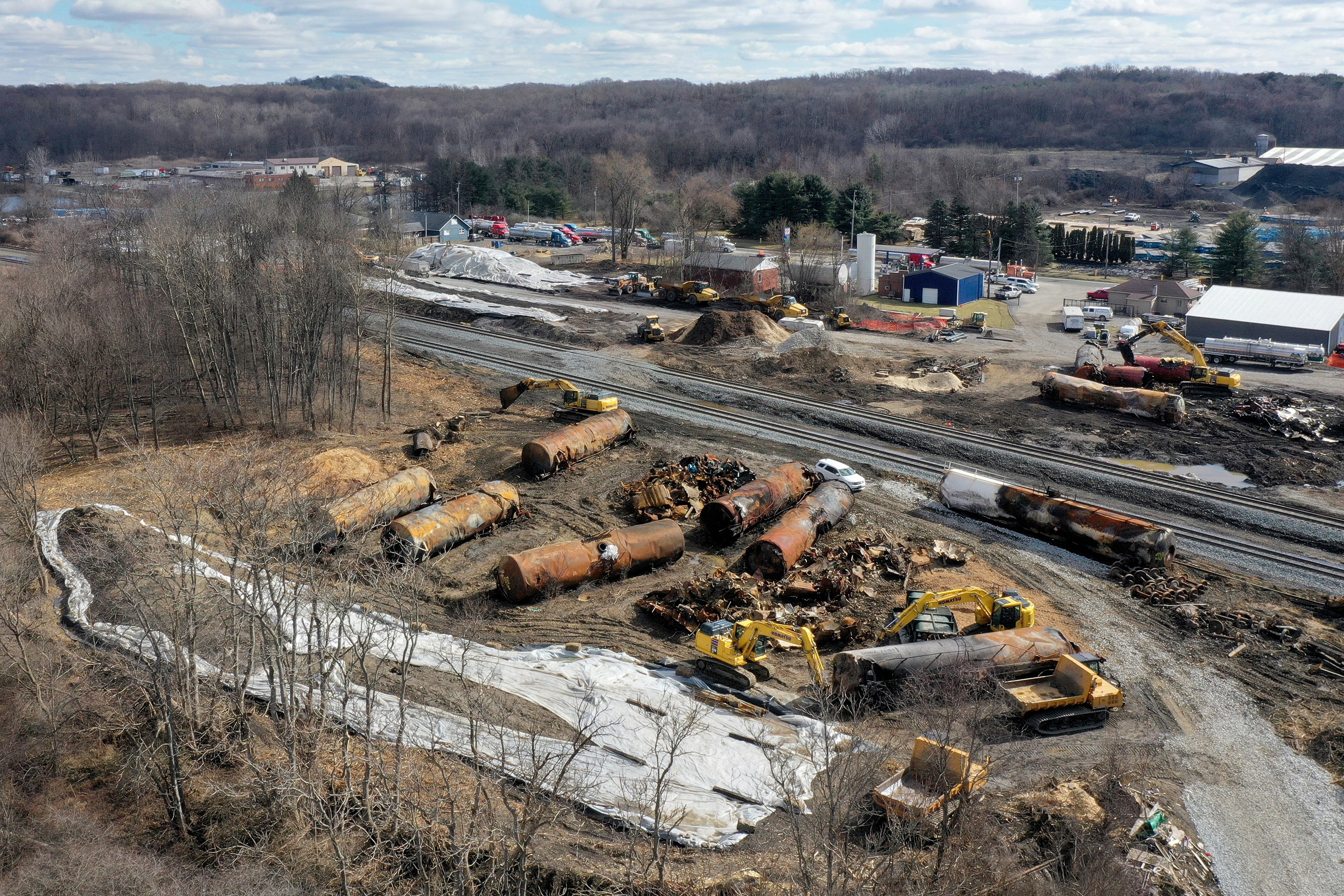Investigation: Persistence Of Toxic Chemicals In Buildings After Ohio Train Derailment

Table of Contents
Types of Toxic Chemicals Released and Their Properties
The Ohio train derailment involved the release of several hazardous chemicals, notably vinyl chloride and butyl acrylate. Understanding the properties of these Ohio train derailment chemicals is crucial to assessing their persistence in buildings.
- Vinyl Chloride: This colorless gas is highly volatile and readily evaporates into the air. However, it can also condense on surfaces and potentially be absorbed into porous building materials. Vinyl chloride health effects include an increased risk of liver cancer, brain tumors, and other serious health problems.
- Butyl Acrylate: A colorless liquid with a pungent odor, butyl acrylate is less volatile than vinyl chloride but can still persist in the environment. Its persistence is influenced by its solubility in water and its potential to bind to certain surfaces. Exposure can cause eye, skin, and respiratory irritation.
Health Risks Associated with Released Chemicals:
- Respiratory problems (shortness of breath, coughing, wheezing)
- Eye and skin irritation
- Neurological effects (headaches, dizziness)
- Increased risk of cancer (depending on the chemical and exposure level)
- Reproductive and developmental toxicity
Methods of Chemical Contamination of Buildings
The released chemicals contaminated buildings through several pathways:
- Air Infiltration: Volatile chemicals like vinyl chloride readily infiltrated buildings through cracks, windows, and ventilation systems. Air infiltration rates and building design significantly influence the level of contamination.
- Surface Deposition: Chemicals deposited on building exteriors (e.g., through rainfall or settling dust) can subsequently be tracked indoors or leach into the building structure over time. The building material permeability plays a crucial role here.
- Water Contamination: If groundwater or surface water sources were contaminated, they could lead to chemical contamination via building plumbing systems or seepage into basements.
Factors influencing contamination levels include building age, material composition, ventilation effectiveness, and proximity to the derailment site. Buildings closer to the derailment and with poor ventilation are more likely to show higher levels of chemical contamination.
Studies and Evidence of Chemical Persistence
While comprehensive long-term studies are still ongoing, preliminary findings indicate the persistence of certain chemicals in the affected area. Environmental testing and chemical residue analysis are crucial in assessing this persistence. Reports from the EPA and other agencies should be consulted for the latest data. (Insert citations to relevant studies and reports here, linking to sources where possible. Include visual aids like charts/graphs showing chemical detection levels in different building materials or environmental samples if available). Data on the detection of chemical residue in building materials, air samples, and water sources will provide concrete evidence of the ongoing issue.
Health Impacts and Long-Term Concerns
Prolonged exposure to the released chemicals poses significant long-term health effects. Residents and workers in the affected area face potential risks including:
- Chronic respiratory illnesses
- Increased cancer risk
- Cardiovascular problems
- Neurodevelopmental issues in children
Long-term health monitoring of the affected population is essential to fully understand the scope of the health impacts and inform appropriate interventions. This is a significant public health concern requiring sustained attention and resources. The Ohio train derailment health impact will likely be felt for many years to come.
Mitigation and Remediation Strategies
Effective building remediation is critical to protect public health. Strategies include:
- Air Purification: High-efficiency particulate air (HEPA) filtration systems can remove airborne chemicals.
- Surface Cleaning: Thorough cleaning and decontamination of surfaces using appropriate methods.
- Material Replacement: In cases of significant contamination, replacement of affected building materials may be necessary.
However, chemical decontamination and building remediation can be costly and challenging, particularly for older buildings or those with complex construction. The financial burden and logistical difficulties associated with widespread remediation efforts must be carefully considered.
Conclusion: Addressing the Persistence of Toxic Chemicals in Buildings After the Ohio Train Derailment
The persistence of toxic chemicals in buildings after the Ohio train derailment presents a significant and ongoing challenge. The findings clearly demonstrate the potential for long-term health risks associated with exposure to these chemicals. Continued monitoring, comprehensive environmental testing, and robust remediation efforts are vital to mitigate the health impacts and ensure the safety of residents and workers in the affected areas. We urge readers to stay informed about ongoing investigations and support initiatives aimed at addressing the long-term consequences of the persistence of toxic chemicals in buildings following this devastating event. (Include links to relevant organizations like the EPA, local health departments, and support groups here.) Addressing the lingering effects of the Ohio train derailment requires sustained commitment and collaborative action.

Featured Posts
-
 Shifting Alliances How Indias Stance Affects Pakistans Trade With Turkey And Azerbaijan
May 18, 2025
Shifting Alliances How Indias Stance Affects Pakistans Trade With Turkey And Azerbaijan
May 18, 2025 -
 Crucial Phone Call Leading To Bin Ladens Capture Revealed In New Netflix Series
May 18, 2025
Crucial Phone Call Leading To Bin Ladens Capture Revealed In New Netflix Series
May 18, 2025 -
 Cybercriminal Made Millions From Compromised Office 365 Accounts
May 18, 2025
Cybercriminal Made Millions From Compromised Office 365 Accounts
May 18, 2025 -
 Amanda Bynes Classmate Claims Tragic School Ritual
May 18, 2025
Amanda Bynes Classmate Claims Tragic School Ritual
May 18, 2025 -
 Maneskins Damiano David Funny Little Fears Debut Solo Album Released
May 18, 2025
Maneskins Damiano David Funny Little Fears Debut Solo Album Released
May 18, 2025
Latest Posts
-
 Bowen Yang Reacts Snls White Lotus Parody With Aimee Lou Wood
May 18, 2025
Bowen Yang Reacts Snls White Lotus Parody With Aimee Lou Wood
May 18, 2025 -
 Aimee Lou Wood And Bowen Yang Discuss Snls White Lotus Sketch
May 18, 2025
Aimee Lou Wood And Bowen Yang Discuss Snls White Lotus Sketch
May 18, 2025 -
 Snls White Lotus Parody Bowen Yang And Aimee Lou Woods Reactions
May 18, 2025
Snls White Lotus Parody Bowen Yang And Aimee Lou Woods Reactions
May 18, 2025 -
 Bowen Yang Wants Out The Search For Snls Next Jd Vance Begins
May 18, 2025
Bowen Yang Wants Out The Search For Snls Next Jd Vance Begins
May 18, 2025 -
 Bowen Yang On Snls White Lotus Parody Featuring Aimee Lou Wood
May 18, 2025
Bowen Yang On Snls White Lotus Parody Featuring Aimee Lou Wood
May 18, 2025
